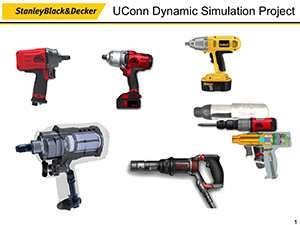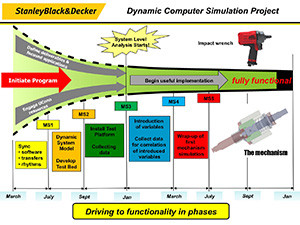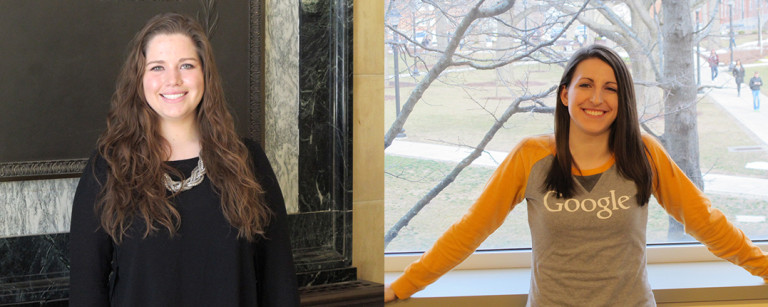Stanley Black & Decker Teams With UConn
Drs. Jiong Tang and Chengyu Cao are collaborating with engineers at global tool giant Stanley Black & Decker to create a methodology to analyze the precise mechanism of tools in two of the company’s product lines, impact wrenches and air hammers, as the key step in developing software capable of shortening the company’s new product development cycle and enhancing the product performance.
Their Stanley Black & Decker collaborator on the project is Mark Lehnert, Vice President of Product Development.
Lehnert explains, “The challenge is that in new product development, the traditional cycle is to design a new product based on empirical experience, build a prototype, performance test it, tweak the design again based on empirical experience, build a new prototype, test it – repeat. Our aim is to create a dynamic simulation model that can eliminate one or more of the prototype stages. If we can design and test a new product on a computer, we have much greater flexibility to tweak the design, change the design parameters and materials without sacrificing time. With a computer, we can run a simulation in four to six hours, while the traditional prototyping cycle can consume up to six months. An effective simulation model will allow us to dramatically cut the time to market for new products and to develop better performing products.”
 Impact wrenches are widely used in infrastructure construction, manufacturing assembly, machine repair and other industrial applications requiring a high torque output. According to Tang, a professor of Mechanical Engineering, the basic mechanism was invented over 80 years ago and exploits the impact momentum produced when an internal hammer is rotated by a motor at an accelerating rate before striking an anvil. The force of the strike results in an impact causing high torque that far exceeds what could be produced solely by the motor, and after striking the anvil, the hammer is quickly retracted and again spun by the motor. In response, the bolt or screw tightens.
Impact wrenches are widely used in infrastructure construction, manufacturing assembly, machine repair and other industrial applications requiring a high torque output. According to Tang, a professor of Mechanical Engineering, the basic mechanism was invented over 80 years ago and exploits the impact momentum produced when an internal hammer is rotated by a motor at an accelerating rate before striking an anvil. The force of the strike results in an impact causing high torque that far exceeds what could be produced solely by the motor, and after striking the anvil, the hammer is quickly retracted and again spun by the motor. In response, the bolt or screw tightens.
Tang remarks, “The power of impact is easy to envision. Consider, for example, throwing a baseball versus striking a baseball with a bat. Within an impact wrench, it is the mechanisms that are complicated: these can generate high-frequency continuous dynamic interactions with high precision and high durability that, to date, are designed based on trial-and-error empirical knowledge.”
The UConn/Stanley Black & Decker team has planned a multi-phase project, with the first step centering on the careful mechanical analysis of the wrench aimed at revealing the precise action underway when the wrench is operating. “Jiong and Chengyu are doing a very ‘deep dive’ analysis that will allow us to understand at a fundamental level the mechanics of the impact wrench. This will lead to the development of better simulation models and allow us to introduce variables such as different materials, heat treating variations and the like,” says Lehnert.
Tang notes that this analysis is complicated because “There are many forces of contact inside the impact wrench, such as when the internal hammer strikes the internal anvil, which cannot be directly observed. And the entire analysis encompasses dynamic events occurring at vastly different time scales, from a micro-second – the duration of a single impact – all the way to thousands of hours, as in the life-span of the tool.”
One challenge involves the gear transmission in impact wrenches. Tang explains that, while gear transmissions are employed in a myriad of machines and are seemingly an ‘old’ subject, researchers do not yet have a complete understanding of these devices, due to the nonlinear gear meshing and time-periodicity, which generate very complex vibratory behaviors that often cause unexpected failures. Tang remarks that these issues are not uncommon in much larger-scale devices such as wind turbines, which are another application area within his research scope. In the case of impact wrench, the problem is further compounded by the consecutive impacts that create additional vibrations. If the vibrations are well understood and then mitigated by new designs, the precision and durability can be enhanced.
To work toward a better understanding of the tool mechanisms, Tang, Cao and their graduate students, Victor Zhang and David Yoo, are developing a dynamic model using a series of software platforms. They combine first-principle based global modeling with local finite element analysis to predict the time-domain response of the impact wrench, and further incorporate advanced frequency-domain-based  algorithms to assist in parametric analysis. This month the two-year project, which began in July 2013, is approaching an important milestone. As the UConn researchers are putting together a system-level dynamic model, Stanley Black & Decker is developing a test bed that will enable the researchers to collect data from a prototype.
algorithms to assist in parametric analysis. This month the two-year project, which began in July 2013, is approaching an important milestone. As the UConn researchers are putting together a system-level dynamic model, Stanley Black & Decker is developing a test bed that will enable the researchers to collect data from a prototype.
Lehnert explains, “The prototype has been fabricated and the process has been documented. The next step is to physically test the prototype and to compare the actual performance against the model’s prediction. A good analogy is the odometer in your car. You don’t know how accurate it is until you calibrate it against a known distance. The predictive model will have to be calibrated and aligned with the real performance of the prototype impact wrench. After the model has been properly aligned at the system level, we will carry out detailed component analysis, which will allow us to predict wear and durability.”
When complete, this process will be repeated, step for step, for the air hammer. Air, or pneumatic, hammers exploit a compressed air and piston system to produce a rapid-fire movement of a piston much like that of a woodpecker drilling for insects on a tree. Air hammers are commonly used to hammer nails, cut metal, engrave ornamental designs onto materials or drill holes.
For Stanley Black & Decker, this industry-university collaboration promises to enable the company to develop more customized, durable tools on a dramatically reduced time-to-market cycle. As the nation redoubles its support for a revival in American manufacturing, academic-industry partnerships are likely to gain increasing momentum.


 team began the four day Formula SAE Competition at Michigan International Speedway in Brooklyn, Michigan. The Formula SAE® Series competitions challenge teams of university undergraduate and graduate students to conceive, design, fabricate and compete with a small, formula style, competition vehicle. To give teams the maximum design flexibility and the freedom to express their creativity and imagination there are very few restrictions on the overall vehicle design. Teams typically spend eight to twelve months designing, building, testing and preparing their vehicles before a competition. The international competitions themselves give teams the chance to demonstrate and prove both their creation and their engineering skills in comparison to teams from other universities around the world. The University of Connecticut has fielded a vehicle in the largest of these competitions, Formula SAE Michigan,
team began the four day Formula SAE Competition at Michigan International Speedway in Brooklyn, Michigan. The Formula SAE® Series competitions challenge teams of university undergraduate and graduate students to conceive, design, fabricate and compete with a small, formula style, competition vehicle. To give teams the maximum design flexibility and the freedom to express their creativity and imagination there are very few restrictions on the overall vehicle design. Teams typically spend eight to twelve months designing, building, testing and preparing their vehicles before a competition. The international competitions themselves give teams the chance to demonstrate and prove both their creation and their engineering skills in comparison to teams from other universities around the world. The University of Connecticut has fielded a vehicle in the largest of these competitions, Formula SAE Michigan,  located at the Michigan International Speedway since the team began just seven years ago. With over 120 colleges and universities registered, Formula SAE Michigan is the largest of its kind. Over the course of four days, the cars are judged in a series of static and dynamic events including: technical inspection, cost, presentation, and engineering design, solo performance trials, and high performance track endurance. These events are scored to determine how well the car performs. Come close of competition the team executed an incredible performance placing 20th overall
located at the Michigan International Speedway since the team began just seven years ago. With over 120 colleges and universities registered, Formula SAE Michigan is the largest of its kind. Over the course of four days, the cars are judged in a series of static and dynamic events including: technical inspection, cost, presentation, and engineering design, solo performance trials, and high performance track endurance. These events are scored to determine how well the car performs. Come close of competition the team executed an incredible performance placing 20th overall out of the 120 teams in attendance at one of the most competitive events of the year. This milestone places UConn Formula SAE amongst the elite, solidifying that they are a force to be reckoned with. In the midst of teams with decades of experience, a sizable team base, and much larger budgets, UConn Formula SAE is still considered in its youth as building a successful vehicle involves extensive growth in both engineering and team dynamics. With the continuing support of sponsors and the department of mechanical engineering, UConn Formula SAE is working towards even greater success with the refined design and manufacture of the 2014-2015 vehicle already underway.
out of the 120 teams in attendance at one of the most competitive events of the year. This milestone places UConn Formula SAE amongst the elite, solidifying that they are a force to be reckoned with. In the midst of teams with decades of experience, a sizable team base, and much larger budgets, UConn Formula SAE is still considered in its youth as building a successful vehicle involves extensive growth in both engineering and team dynamics. With the continuing support of sponsors and the department of mechanical engineering, UConn Formula SAE is working towards even greater success with the refined design and manufacture of the 2014-2015 vehicle already underway. The four-day competition brings together teams of university undergraduate and graduate students from around the world to conceive, design, fabricate and compete with a small, formula style, competition vehicle. To give teams the maximum design flexibility and the freedom to express their creativity and imagination, there are very few restrictions on the overall vehicle design. Teams typically spend eight to twelve months designing, building and preparing their vehicles before a competition.
The four-day competition brings together teams of university undergraduate and graduate students from around the world to conceive, design, fabricate and compete with a small, formula style, competition vehicle. To give teams the maximum design flexibility and the freedom to express their creativity and imagination, there are very few restrictions on the overall vehicle design. Teams typically spend eight to twelve months designing, building and preparing their vehicles before a competition. Impact wrenches are widely used in infrastructure construction, manufacturing assembly, machine repair and other industrial applications requiring a high torque output. According to Tang, a professor of Mechanical Engineering, the basic mechanism was invented over 80 years ago and exploits the impact momentum produced when an internal hammer is rotated by a motor at an accelerating rate before striking an anvil. The force of the strike results in an impact causing high torque that far exceeds what could be produced solely by the motor, and after striking the anvil, the hammer is quickly retracted and again spun by the motor. In response, the bolt or screw tightens.
Impact wrenches are widely used in infrastructure construction, manufacturing assembly, machine repair and other industrial applications requiring a high torque output. According to Tang, a professor of Mechanical Engineering, the basic mechanism was invented over 80 years ago and exploits the impact momentum produced when an internal hammer is rotated by a motor at an accelerating rate before striking an anvil. The force of the strike results in an impact causing high torque that far exceeds what could be produced solely by the motor, and after striking the anvil, the hammer is quickly retracted and again spun by the motor. In response, the bolt or screw tightens. algorithms to assist in parametric analysis. This month the two-year project, which began in July 2013, is approaching an important milestone. As the UConn researchers are putting together a system-level dynamic model, Stanley Black & Decker is developing a test bed that will enable the researchers to collect data from a prototype.
algorithms to assist in parametric analysis. This month the two-year project, which began in July 2013, is approaching an important milestone. As the UConn researchers are putting together a system-level dynamic model, Stanley Black & Decker is developing a test bed that will enable the researchers to collect data from a prototype.

 Drs.
Drs.  DOE is committed to increasing the energy efficiency of turbines through the use of thermal barrier coatings, which are highly advanced material systems that are applied to insulate the metallic components of machines operating at high temperatures. For these turbines to become more efficient, however, they must operate at a temperate above current thermal barrier coatings’ limit of 1200°C. Higher temperature thermal barrier coatings would permit engines to operate more efficiently at higher temperatures, thus saving fuel and reducing greenhouse emissions. Alternatively, the thermal barrier coatings can be used at the same turbine temperatures and provide improved turbine component durability.
DOE is committed to increasing the energy efficiency of turbines through the use of thermal barrier coatings, which are highly advanced material systems that are applied to insulate the metallic components of machines operating at high temperatures. For these turbines to become more efficient, however, they must operate at a temperate above current thermal barrier coatings’ limit of 1200°C. Higher temperature thermal barrier coatings would permit engines to operate more efficiently at higher temperatures, thus saving fuel and reducing greenhouse emissions. Alternatively, the thermal barrier coatings can be used at the same turbine temperatures and provide improved turbine component durability. HiFunda has established a Thermal Spray Facility within the technology incubator at UConn’s Depot campus, moved a senior researcher to UConn, and is providing funds for capital equipment and supplies. The company’s intention is to license this UConn-patented technology and to establish a new company at UConn to further develop and market the SPPS technology.
HiFunda has established a Thermal Spray Facility within the technology incubator at UConn’s Depot campus, moved a senior researcher to UConn, and is providing funds for capital equipment and supplies. The company’s intention is to license this UConn-patented technology and to establish a new company at UConn to further develop and market the SPPS technology.